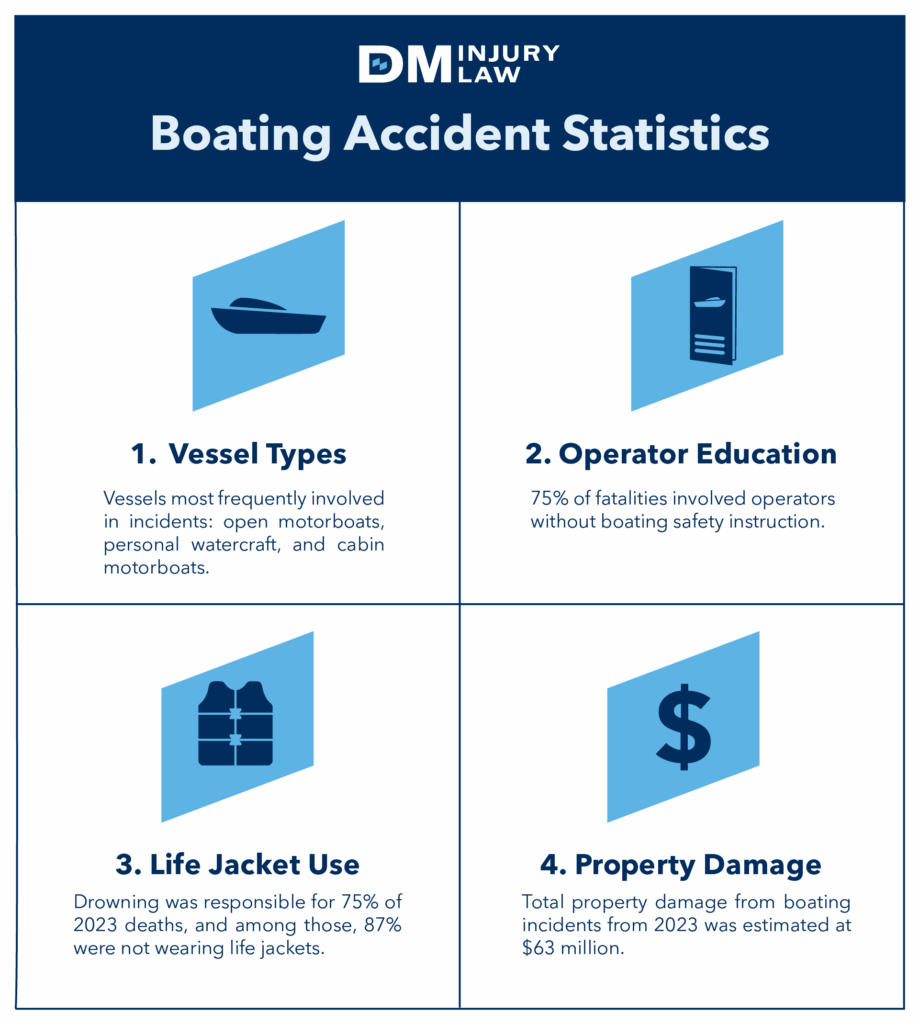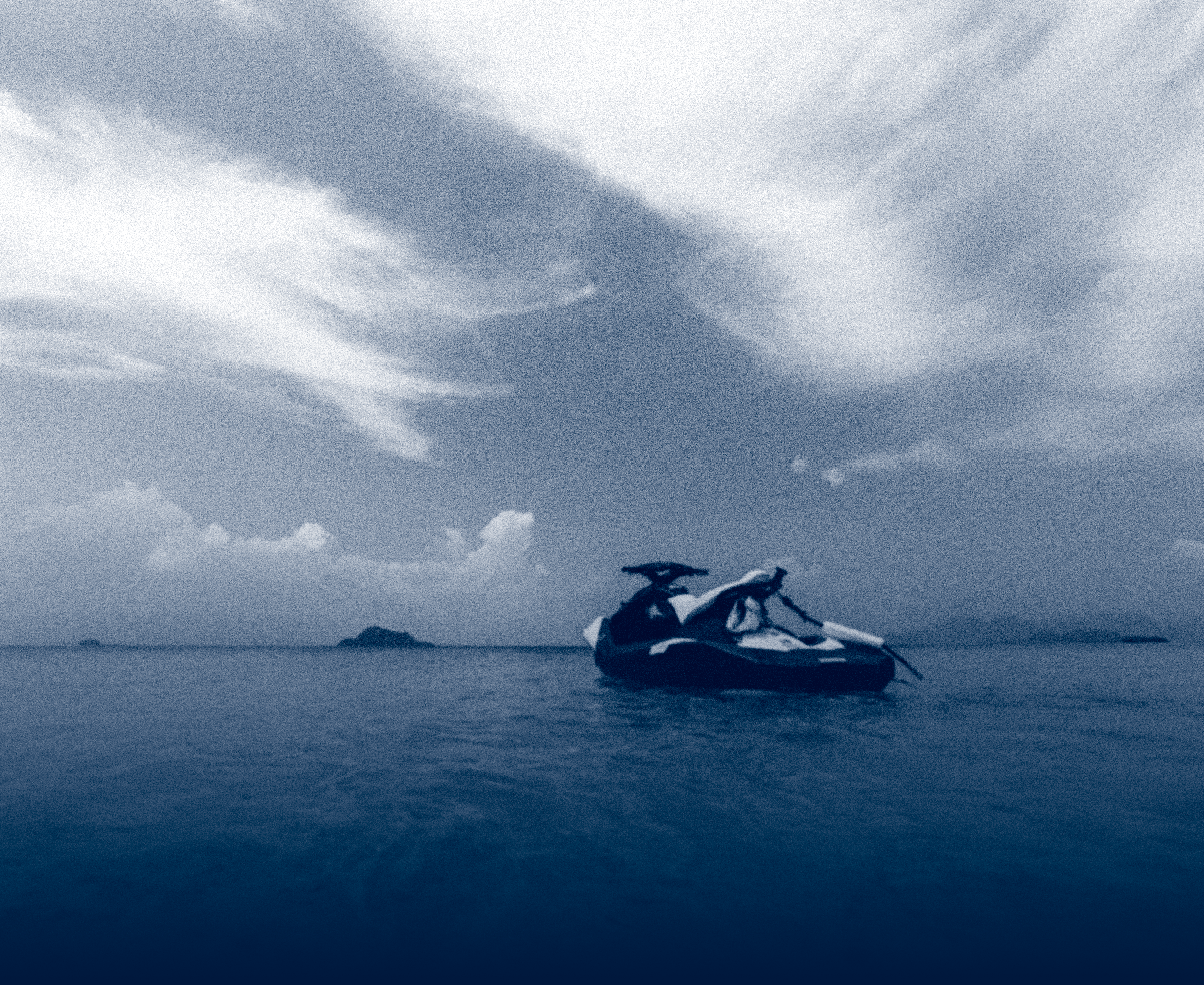Jet skis are a thrilling way to enjoy time on the water, but they also come with real risks. Every year, riders are injured or killed in boating accidents involving jet skis, often due to preventable mistakes. Whether you’re a first-time rider or a seasoned enthusiast, understanding jet ski safety is crucial to protecting yourself and others.
Why Jet Ski Safety Matters
Jet skis can travel at speeds of over 60 mph, but, unlike cars or boats, they offer no outer protection, making high-speed crashes with other watercraft particularly dangerous.
According to U.S. Coast Guard jet ski accident statistics, thousands of boating accidents, including jet ski injuries, are reported each year. Many involve collisions with other jet skis or boats and are caused by factors such as:
- Rider inexperience
- Loss of control
- Speeding in unsafe areas
- Alcohol or drug impairment
- Lack of proper gear, like life jackets or wetsuits

Common Jet Ski Injuries
A jet ski injury can range from minor scrapes to life-threatening trauma. Some of the most frequently reported jet ski injuries include:
- Broken bones or fractures
- Cuts or internal bleeding
- Burns from fuel or engine
- Drowning
These injuries often occur when riders are thrown off their watercraft at high speeds and collide with docks, boats, or other people.
Jet Ski Dangers: What Causes Most Accidents?
Jet ski accidents don’t just result from reckless behavior. Many dangers arise because of factors such as:
- Inexperience: Many jet ski riders do not know how to steer properly or safely handle a jet ski at high speeds.
- Lack of Safety Training: Failing to understand the rules of the water can result in dangerous collisions.
- Speeding or Showing Off: Operating a jet ski at high speeds reduces reaction time and increases the force of any impact.
- Failure to Wear Safety Gear: Not wearing a life jacket can mean the difference between surviving an accident and drowning.
- Riding in Congested or Restricted Areas: Navigating through crowded lakes or marinas significantly increases the risk of collisions.
- Mechanical Failure or Lack of Maintenance: Malfunctions like faulty brakes or engine problems can cause the rider to lose control.
Jet Ski Safety Requirements to Know Before You Ride
Whether you rent or own a jet ski, following jet ski safety requirements can help you avoid unnecessary risks.
- Inspect the watercraft before use.
- Check for fuel leaks, engine issues, and working lights.
- Review local laws and age restrictions before heading out.
- Complete a jet ski safety course.
- Always wear a life jacket.
- Keep the safety lanyard attached to your person.
- Stay clear of swimmers, the dock, and boat traffic.
- Avoid riding at night or when visibility is poor.
Can You Jet Ski If You Can’t Swim?
Technically, you could ride a jet ski if you can’t swim, but it is not recommended. While wearing a life jacket can help, it may not save you in strong currents, rough water, or panic situations.
If you fall off, you may become disoriented, trapped under the ski, or swept away. Even skilled swimmers can struggle under specific circumstances. Non-swimmers are at a higher risk of drowning-related jet ski injuries even with a flotation device.
Take basic swimming lessons before riding and never ride alone or without supervision if you are a novice swimmer.
How Common Are Jet Ski Accidents?
Wondering how common jet ski accidents are? You’re not alone. Jet ski accidents involve capsizing, collisions, falling overboard, and more.
According to boating data published by the Coast Guard in 2024, personal watercraft accounted for about 19% of all recreational boating incidents in 2024. These vessels were involved in 601 casualties (38 deaths and 563 injuries).
These crashes tend to involve younger or inexperienced jet ski operators and are more likely to occur when water traffic and risk levels are highest.
To make jet skiing safe, follow these best practices every time you hit the water:
- Stay within your comfort zone and don’t push the limits of speed or maneuvering.
- Take a certified safety course either online or in person.
- Ride sober and avoid alcohol if you know you’ll be out on the water.
- Be aware of no-wake zones, water depth, and other hazards in the area.
- Ride defensively by anticipating other boaters and riders.
- Always ride with a buddy, especially if you are going far from shore.
DM Injury Represents Victims of Water Accidents
Jet skis offer fun and freedom on the water, but they also come with real risks. If you’ve been involved in a jet ski accident caused by someone else’s negligence, you may be entitled to compensation.
DM Injury Law has your back and will work tirelessly to fight for the compensation you deserve. Reach out today for a free consultation. We work on a contingency fee basis, which means we only get paid if you do.
Want more safety tips for this summer? Sign up for our monthly newsletter.




